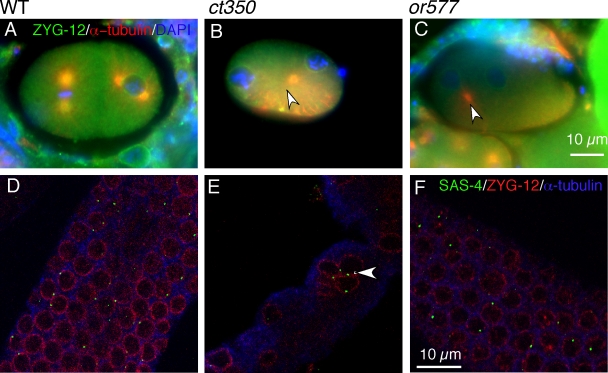Figure 6.
There are different mechanisms controlling centrosome attachment in the embryo and the germline. (A–C) ZYG-12 is required for centrosomal attachment in the embryo. Immunofluorescent images of embryos incubated at the restrictive temperature for 6 h labeled with ZYG-12 (green) to mark the nuclear envelope and α-tubulin (red) to mark the centrosome. (A) The centrosomes are attached to the nuclei in a two-cell stage embryo. (B and C) Centrosomes (arrowheads) are detached from the nuclei in zyg-12(ct350) and zyg-12(or577) embryos. (D–F) ZYG-12 is dispensable for centrosome attachment in the gonad, and loss of nuclear anchoring is independent of centrosome attachment. Immunofluorescent images of gonads incubated at the restrictive temperature for 6 h labeled with antibodies to SAS-4 (green) to mark centrosomes, ZYG-12 (red) to mark nuclei, and α-tubulin (blue). Centrosomes remain closely apposed to the nuclear envelope of wild-type (WT) nuclei (D), zyg-12(ct350) nuclei that have been displaced (E), and zyg-12(or577) nuclei (F). Note that in wild-type and both mutants, the SAS-4 signal is visible at all nuclei but does not appear in images only because of the focal plane of the confocal image. Although nuclear position was disrupted, centrosomes still remain on the nuclear envelope of the zyg-12(ct350) mutants (E, arrowhead).

